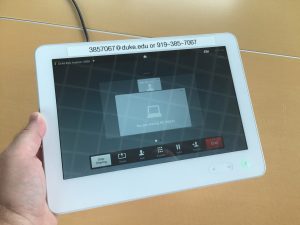At the Duke Eye Center, Guy Miller and Michael Juday thought they were going to give a quick tour of their new “Cisco Only” or “Crestronless” conference room to Pratt School of Engineering’s IT Dean Jim Daigle. Little did they know that I, Paul Zylowski (Manager, Trinity AV), Richard Mitchell (Sanford School) and Michael Jessup (Fuqua) would barge in and turn it into an impromptu DDMC meeting.
When Guy joined Duke Health IT, he was presented a challenge – try to get a handle on the individualistic approach to AV room integration across the medical system which has created high costs, support complexity and lack of any consistency between spaces. Crestron programming was identified as a cost and complexity item that should be evaluated.
Duke Health benefits from the fact that they require secure communications to protect confidential health information. I say “benefits from” because that is an iron clad requirement and helps the standardization of AV rooms.
Duke Health partnered with Cisco to deploy a number of video conferencing systems that also act as all in one presentation systems and telephones for a room. This is the single MX800.
Cisco’s touch screens require no programming and are super simple to use. They’ve deployed some of their “all in one” integrated systems (Dual MX-800) which further simplified implementation.
Even in larger rooms such as this one, they deployed a two screen, three camera system that does voice tracking camera switch or manual camera switch from the Cisco touch panel without the need of any Crestron programming.
For larger spaces such as this one, they still employ a standard Crestron integration. They’ve worked hard to provide a standard interface when deploying Crestron and took the unique approach to making their interface task based vs. source/destination based.
This was an excellent solution for Duke Health driven by the need of hardware based codec for security. We discussed at length if such an approach would be beneficial on the University side. While there are some hardware based systems being deployed, it seems that many of the current implementations, including the new Duke Technology Engagement Center, are not centered around hardware video conference codecs. Many in the University community use WebEx extensively while others want the flexibility to use Skype, Google Hangouts or other web conferencing solutions. Unfortunately a Cisco Codec does not provide a USB audio/video output so deploying a hardware codec limits you to hardware video conferencing or deploying of two different solutions in the same room.
That said, Duke OIT and Duke Health IT are currently testing the WebEx Collaboration Meeting Room – this will allow hardware based SIP codecs to connect into a WebEx session. We don’t think that will drive people to install codecs in their conference rooms but would allow the “soft codec” using an AV Bridge or new Panasonic camera with USB out (and audio in) to accept participation from hardware codecs as part of their WebEx call. Look for more information on The WebEx CMR soon.







